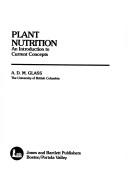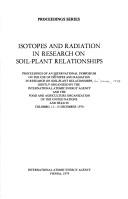| Listing 1 - 4 of 4 |
Sort by
|
Dissertation

ISBN: 9789088260742 Year: 2008 Publisher: Leuven K.U.Leuven. Faculteit Bio-ingenieurswetenschappen
Abstract | Keywords | Export | Availability | Bookmark
 Loading...
Loading...Choose an application
- Reference Manager
- EndNote
- RefWorks (Direct export to RefWorks)
Black Leaf Streak Disease (BLSD) caused by the fungus Mycosphaerella fijiensis Morelet is the major leaf disease of banana plants. This disease reduces the foliar area, causes premature fruit yellowing and can reduce the yield up to 100%. Over the past 40 years, this disease was controlled with fungicides. Because of its fasting cycling and sexual reproduction capacity, some pathogen characteristics have changed making the pathogen more resistant to fungicides. This has resulted in heavier fungicide applications with adverse consequences on the environment and human health while at the same time increased substantially the cost of production. Breeding for BLSD resistant banana plants has given limited results while the search for new fungicides goes on. Complementary strategies need to be considered, such as a balanced nutrition of the host which influences the disease dynamics. This thesis analysed an organic commercial production system where BLSD is present but does not cause much damage (still 8.5 green leaves remain at harvest). The effects of organic tea (OT) application on the host, the pathogen and the BLSD disease, as the basis of the current organic banana production system were investigated. In addition the thesis assessed the effects of several nutrients on the BLSD, the banana plant and M. fijiensis Morelet and makes suggestions for their incorporation in an improved integrated pest management program for commercial banana production. The research was conducted in vitro, in the greenhouse and under field conditions where the growth and development of the M. fijiensis Morelet pathogen, the banana plant and the disease was evaluated. A conventional production system, with fertilizer and fungicides, was used as a reference. Fungal isolates of M. fijiensis Morelet from both the organic and conventional production systems behaved similarly in vitro and both had the same potential to generate the disease. Therefore the hypothesis was that the regular OT applications were giving a good BLSD control. It was shown that the OT inhibited the fungus but its effects were variable and depended on the location of production, time of sampling, concentration, etc. Because of the variable ingredients/parameters, the used OT had a highly variable nutrient composition. Consequently the response of the fungus was studied to those nutrients which have a demonstrated effect on a plant’s defence system in other crops. Boron, Copper, Manganese and Zinc (B, Cu, Mn and Zn) delayed the fungus development in vitro as long as they were present in the medium. However once nutrients were removed from the medium, only Cu was shown to have a lasting inhibitory effect on the fungus. The inhibitory effect of the micronutrients was maximal at a high or low pH. As banana is a Silicon (Si) accumulator, Si effects were also explored. M. fijiensis Morelet was inhibited by Si and inhibition increased with higher Si concentrations. However, once Si is removed from the in vitro medium, fungal growth recovered. In vitro banana plants grew better with Si and especially the roots benefited. Under greenhouse conditions, OT stimulated plant growth and development while BLSD was reduced if OT was applied continuously. Micronutrients applied in the greenhouse reduced disease symptoms and stimulated plant growth. Si applied directly to the roots had a much greater effect on plant growth and disease reduction than when applied to the leaves. Under field conditions similar observations were found. The OT effects became clearer with a longer duration of application, i.e. better effects on the next generation (sucker) plants than on the mother plants. Si treatments benefited the plant growth but the effect on the disease was not clear, presumably because the experiment did not last long enough to establish the effects in the following cycle. In contrast, nitrogen applications stimulated BLSD development. This calls for a modified fertilizer regime in the conventional banana production system.
Academic collection --- 634.771 --- 632.4 --- 631.81.033 --- <866> --- <866> Ecuador --- Ecuador --- 631.81.033 Conversion and distribution in the plant. Nutrient status of plants --- Conversion and distribution in the plant. Nutrient status of plants --- 632.4 Algal and fungal diseases of plants. Plant mycoses etc. --- Algal and fungal diseases of plants. Plant mycoses etc. --- 634.771 Musa species in general --- Musa species in general --- Theses
Book
ISBN: 9066051841 Year: 1990 Volume: 274 Publisher: Wageningen ISHS
Abstract | Keywords | Export | Availability | Bookmark
 Loading...
Loading...Choose an application
- Reference Manager
- EndNote
- RefWorks (Direct export to RefWorks)
631.81.095.337 --- 631.81.095.338 --- 632.07 --- 632.12 --- 631.81.033 --- Requirement for certain elements. Essential micronutrients. Trace elements --- Lack of certain elements. Mineral deficiency --- Analysis and diagnosis --- Unfavourable soil conditions --- Conversion and distribution in the plant. Nutrient status of plants --- 631.81.033 Conversion and distribution in the plant. Nutrient status of plants --- 632.12 Unfavourable soil conditions --- 632.07 Analysis and diagnosis --- 631.81.095.338 Lack of certain elements. Mineral deficiency --- 631.81.095.337 Requirement for certain elements. Essential micronutrients. Trace elements --- Fruit trees --- Nutrition --- Congresses

ISBN: 0867200804 Year: 1989 Publisher: Boston Jones and Bartlett
Abstract | Keywords | Export | Availability | Bookmark
 Loading...
Loading...Choose an application
- Reference Manager
- EndNote
- RefWorks (Direct export to RefWorks)
Plants --- Plants, Effect of minerals on --- 581.13 --- 631.81.031 --- 631.81.033 --- 631.81.036 --- Minerals --- Plant nutrition --- Nutrition --- Plant physiology --- Nutrition. --- Assimilation. Nutrition. Reserves. Secretions. Metabolism --- Absorption, uptake of nutrients --- Conversion and distribution in the plant. Nutrient status of plants --- Biodynamic processes. Soil-plant interactions --- Physiological effect --- Effect of minerals on. --- 631.81.036 Biodynamic processes. Soil-plant interactions --- 631.81.033 Conversion and distribution in the plant. Nutrient status of plants --- 631.81.031 Absorption, uptake of nutrients --- 581.13 Assimilation. Nutrition. Reserves. Secretions. Metabolism --- Effect of minerals on

ISBN: 9200103790 Year: 1979 Publisher: Vienna International atomic energy agency
Abstract | Keywords | Export | Availability | Bookmark
 Loading...
Loading...Choose an application
- Reference Manager
- EndNote
- RefWorks (Direct export to RefWorks)
631.81.036 --- 57.088.6 --- 581.1 --- 631.81.031 --- 631.81.033 --- Crops and soils --- -Radioactive tracers in plant nutrition --- -Radioactive tracers in soil science --- -Soil science --- Plants --- Crops --- Field crops --- Soils and crops --- Plant-soil relationships --- Soils --- Biodynamic processes. Soil-plant interactions --- Methods and techniques for studying metabolism and biotransformation.Radioisotopes methods and techniques. --- Plant physiology --- Absorption, uptake of nutrients --- Conversion and distribution in the plant. Nutrient status of plants --- Research --- -Congresses --- Congresses --- Nutrition --- -Biodynamic processes. Soil-plant interactions --- 631.81.033 Conversion and distribution in the plant. Nutrient status of plants --- 631.81.031 Absorption, uptake of nutrients --- 581.1 Plant physiology --- 57.088.6 Methods and techniques for studying metabolism and biotransformation.Radioisotopes methods and techniques. --- 631.81.036 Biodynamic processes. Soil-plant interactions --- -631.81.033 Conversion and distribution in the plant. Nutrient status of plants --- Radioactive tracers in plant nutrition --- Radioactive tracers in soil science --- Soil science --- Research&delete& --- Methods and techniques for studying metabolism and biotransformation.Radioisotopes methods and techniques --- Report
| Listing 1 - 4 of 4 |
Sort by
|

 Search
Search Feedback
Feedback About UniCat
About UniCat  Help
Help News
News